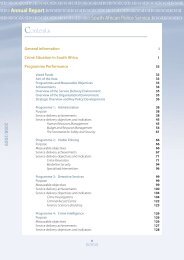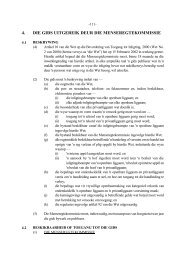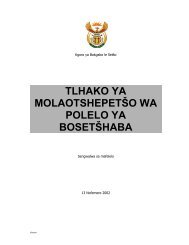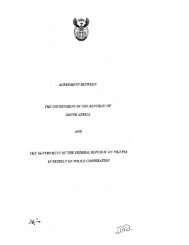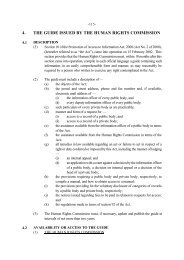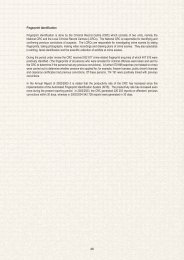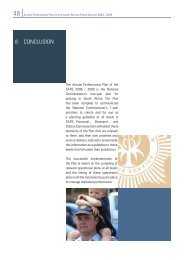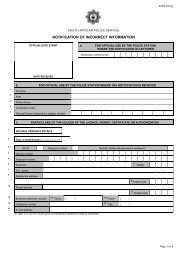Part 13 - Saps
Part 13 - Saps
Part 13 - Saps
You also want an ePaper? Increase the reach of your titles
YUMPU automatically turns print PDFs into web optimized ePapers that Google loves.
316<br />
responsibilities. 20 The South African distribution appears to be the opposite of international<br />
policing norms. While the ratio of sergeants to constables is 1.5 to 1 in South Africa, it is 1<br />
to 4.5 in Australia, 1 to 5 in Britain and 1 to 6.4 in the United States. Sergeants and<br />
constables comprise over 90% of all members in Australia and Britain. In South Africa<br />
they comprise under a third (30%) of total staff (excluding civilian personnel). 21 The result<br />
is that there is no real differentiation of function between non-commissioned officers. The<br />
virtue of a military-type structure, with every incident having a clear line of responsibility<br />
associated with it, is blurred in the SAPS.<br />
As a consequence of the relatively small number of junior ranked officers, the SAPS has<br />
become an over-managed organisation, where the higher management echelons devour<br />
personnel-related resources at the expense of junior officers responsible for station and<br />
street-level policing work. However, the low proportion of constables in the SAPS will be<br />
alleviated significantly by the recruitment of the additional 30,200 entry-level constables<br />
by early 2006.<br />
Criminal investigations<br />
The general quality of the police’s detective work appears to have declined in the post-<br />
1994 period. This was partly to be expected. Before 1994, the South African Police (SAP)<br />
used authoritarian policing methods and tough law enforcement strategies to combat crime.<br />
Using a confession based approach to solving crime, some SAP detectives were more<br />
concerned about getting crime suspects convicted than upholding the law and conducting<br />
investigations in a legally correct manner. 22 Changing from a confession based to an<br />
evidence based manner of collecting evidence, required a significant change in the way<br />
many experienced detectives performed their work.<br />
Detectives are overloaded with cases – as much the result of mismanagement than of vast<br />
numbers of cases alone. Instead of teaming up to tackle cases on a case by case basis, each<br />
detective gets an unmanageable load to tackle on his own. 23<br />
Detectives argue that, at the most, they can properly deal with ten serious cases at any one<br />
time. Officially, the ideal number of dockets per detective is 18. 24 However, even<br />
detectives from specialised units often have to handle 50 or 60 matters at any one time.<br />
The consequence of such overloading is that the investigation is administered rather than<br />
the case solved. Investigated cases become so old that they are eventually dropped as the<br />
complainant, witnesses, and other persons involved lose interest. Alternatively, evidence<br />
may be lost and witnesses’ memories may fail them. Withdrawals of charges, and<br />
prosecutors declining to prosecute are often the result.<br />
20 Leggett T. ‘Everyone’s an inspector: the crisis of rank inflation and the decline of visible policing’ in SA<br />
Crime Quarterly 1 (Institute for Security Studies,Pretoria, 2002) p 23)<br />
21 Ibid.<br />
22 See Altbeker A. Solving crime. The state of the SAPS detective service (Institute for Security Studies,<br />
Pretoria, 1998) p 49, where the point is made that a confession driven investigative approach did not<br />
dominate all SAP detective units. Many units – especially those dealing with less serious crimes - relied<br />
less on confessions and complied more closely with the law.<br />
23 Redpath J. Leaner and meaner? Restructuring the SAPS detective service (Institute for Security Studies,<br />
Pretoria, 2002)<br />
24 S. V. Tshwete, Minister of Safety and Security, written reply to parliamentary question no. 1111, National<br />
Assembly, 15 June 2001.



